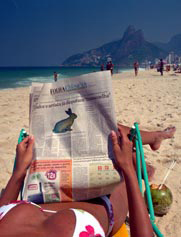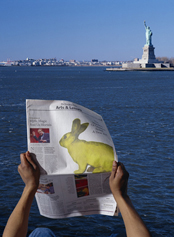Follow the Green Rabbit
Eduardo Kac
GFP Bunny, 2000

“Alba”, the green fluorescent bunny, is an albino rabbit. This means that, since she has no skin pigment, under ordinary environmental conditions she is completely white with pink eyes. Alba is not green all the time. She only glows when illuminated with the correct light. When (and only when) illuminated with blue light (maximum excitation at 488 nm), she glows with a bright green light (maximum emission at 509 nm). She was created with EGFP, an enhanced version (i.e., a synthetic mutation) of the original wild-type green fluorescent gene found in the jellyfish Aequorea Victoria. EGFP gives about two orders of magnitude greater fluorescence in mammalian cells (including human cells) than the original jellyfish gene.
The first phase of the “GFP Bunny” project was completed in February 2000 with the birth of “Alba” in Jouy-en-Josas, France. This was accomplished with the invaluable assistance of zoosystemician Louis Bec and scientists Louis-Marie Houdebine and Patrick Prunet. Alba’s name was chosen by consensus between my wife Ruth, my daughter Miriam, and myself. The second phase is the ongoing debate, which started with the first public announcement of Alba’s birth, in the context of the Planet Work conference, in San Francisco, on May 14, 2000. The third phase will take place when the bunny comes home to Chicago, becoming part of my family and living with us from this point on.
Alba is a healthy and gentle mammal. Contrary to popular notions of the alleged monstrosity of genetically engineered organisms, her body shape and coloration are exactly of the same kind we ordinarily find in albino rabbits. Unaware that Alba is a glowing bunny, it is impossible for anyone to notice anything unusual about her. Therefore Alba undermines any ascription of alterity predicated on morphology and behavioral traits. It is precisely this productive ambiguity that sets her apart: being at once same and different. The mystery and beauty of life is as great as ever when we realize our close biological kinship with other species and when we understand that from a limited set of genetic bases life has evolved on Earth with organisms as diverse as bacteria, plants, insects, fish, reptiles, birds, and mammals.


Alba is undoubtedly a very special animal, but I want to be clear that her formal and genetic uniqueness are but one component of the “GFP Bunny” artwork. The “GFP Bunny” project is a complex social event that starts with the creation of a chimerical animal that does not exist in nature (i.e., “chimerical” in the sense of a cultural tradition of imaginary animals, not in the scientific connotation of an organism in which there is a mixture of cells in the body) and that also includes at its core:
1) ongoing dialogue between professionals of several disciplines (art, science, philosophy, law, communications, literature, social sciences) and the public on cultural and ethical implications of genetic engineering;
2) contestation of the alleged supremacy of DNA in life creation in favor of a more complex understanding of the intertwined relationship between genetics, organism, and environment;
3) extension of the concepts of biodiversity and evolution to incorporate precise work at the genomic level;
4) interspecies communication between humans and a transgenic mammal;
5) integration and presentation of “GFP Bunny” in a social and interactive context;
6) examination of the notions of normalcy, heterogeneity, purity, hybridity, and otherness;
7) consideration of a non-semiotic notion of communication as the sharing of genetic material across traditional species barriers;
8) public respect and appreciation for the emotional and cognitive life of transgenic animals;
9) expansion of the present practical and conceptual boundaries of artmaking to incorporate life invention.

‘I will never forget the moment when I first held her in my arms, in Jouy-en-Josas, France, on April 29, 2000. My apprehensive anticipation was replaced by joy and excitement. Alba — the name given her by my wife, my daughter, and I — was lovable and affectionate and an absolute delight to play with. As I cradled her, she playfully tucked her head between my body and my left arm, finding at last a comfortable position to rest and enjoy my gentle strokes. She immediately awoke in me a strong and urgent sense of responsibility for her well-being’.
januari 4th, 2009 at 09:07
Thanks! This really helped in my Biotech report! ^_^